Soccer, known as Football outside the United States, is more than just a sport; it is a global phenomenon that crosses cultural and national barriers. With its modest requirements—a ball and somewhere to play—it has become the globe’s most popular sport, attracting billions of viewers and players worldwide.
Soccer’s popularity in the United States is surging, backed by a young, diverse fan base and significant events like the 1994 FIFA World Cup and Major League Soccer (MLS) establishment.
Soccer fans in the U.S. are notably younger and more diverse than those of other major sports, with a significant following among the Latino community, reflecting the country’s second-largest Spanish-speaking population.
The collaboration between MLS and Mexico’s Liga MX, alongside the rapid growth of the National Women’s Soccer League (NWSL), showcases soccer’s expanding influence.
Recent record attendances and strategic media deals, including MLS’s partnership with Apple, highlight the sport’s growing footprint. Investments from notable personalities in NWSL teams and the rise in soccer’s viewership among Latinos underscore its burgeoning impact.
Soccer’s potential in the U.S. sports landscape is more promising than ever, driven by its broad, inclusive appeal and rising consumer power within Latino communities.
This article talks about the history of soccer, delving into its origins, evolution into the modern era, and unique place in American culture.
The Origins of Soccer
The history of soccer is a variety of games played across ancient civilizations. In China, the game of cuju, described in military manuals from the Han Dynasty, is often cited as an early ancestor of soccer. Players kicked a leather ball filled with feathers through an opening into a small net, showcasing the game’s ancient roots in skill and competition.
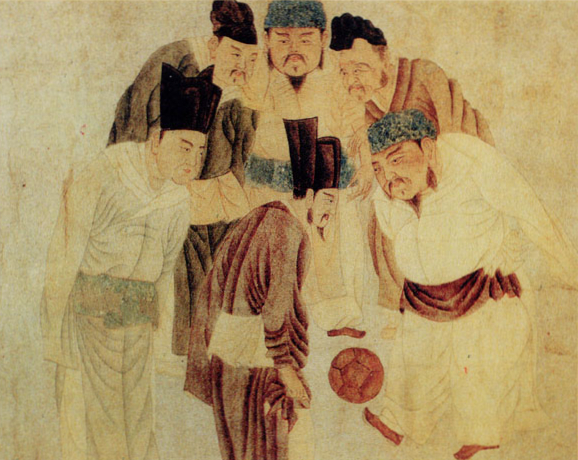
Image Source –Emperor Taizu play Cuju
Similar games were found in Japan, Egypt, and among Indigenous peoples in North and South America, each with variations and cultural significance.
In medieval Europe, the precursor to modern soccer was much more chaotic. Towns and villages across England would engage in mass games where the objective was to move a ball to a predetermined spot, with matches often involving hundreds of participants and lasting several days.
These early games were more about community involvement and celebration than the sport we recognize today. However, they laid the foundational spirit of teamwork and competition that defines soccer.
When Was Soccer Invented?

Image Source: Game Resembling Football in The Middle Ages
In the 12th century, the foundations of what would eventually evolve into soccer were laid in the green expanses of England. This primitive iteration was known as ‘Folkball,’ a game that, although sharing the kicking aspect with modern soccer, was markedly different due to its violent nature, including punching the ball and aggressive physical confrontations with opponents.
Its rough and tumble nature led to a widespread ban by the British government, deeming it too dangerous for public amusement
It wasn’t until the 19th century that soccer re-emerged from the shadows of prohibition, transforming into a regulated winter pastime within the confines of English public schools such as Eton, Winchester, and Charterhouse. This revival, however, was not without its challenges.
A significant obstacle was the lack of uniformity in the rules. At the same time, some institutions embraced a style akin to rugby, allowing limited ball handling, while others insisted on a more restrained approach, prohibiting the use of hands altogether.
The discrepancy in rules posed a significant barrier to inter-school competition until a pivotal moment in 1848 when the Cambridge Rules were introduced. These rules represented the first attempt to unify the game’s regulations, laying a foundation for what soccer would become.
However, they stopped short of clarifying the handling of the ball. This ambiguity lingered until the historic formation of the first Football Association (FA) in 1863 in London.
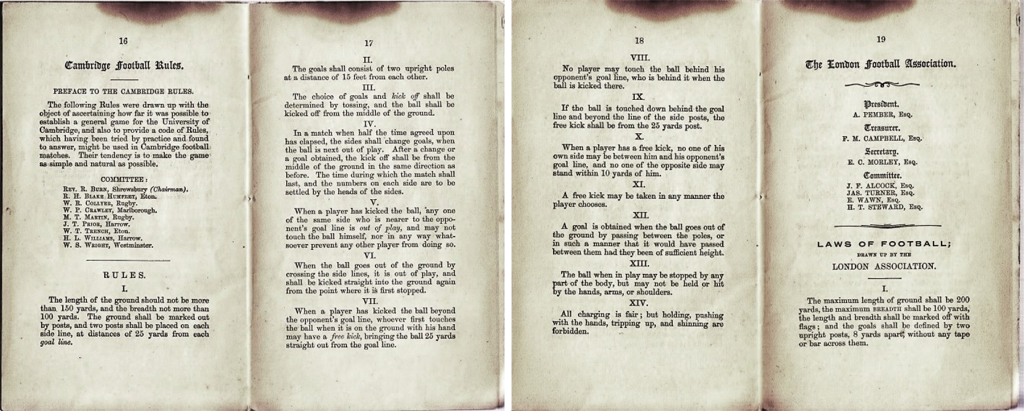
(Source: Pages 16-19 The Cambridge Rules of 1863)
The establishment of the FA marked a defining moment in the history of soccer, as it undertook the task of standardizing the game’s rules across the board. This crucial development officially segregated soccer and rugby into two distinct sports.
The new regulations explicitly outlawed the use of hands, except by the goalkeeper, cementing the identity of soccer as a sport primarily focused on the skillful use of feet and strategic play.
This transformation from a chaotic, unregulated activity to a structured, widely embraced sport was monumental. The FA’s establishment of precise, universal rules facilitated the rapid spread of soccer, laying the groundwork for its ascent to become the world’s most beloved sport.
It fostered a sense of camaraderie and sportsmanship that transcended the game’s humble beginnings, paving the way for international competitions and the global soccer community we see today.
This evolution from ‘Folkball’ to modern soccer is a testament to the sport’s resilience and ability to adapt and flourish within the changing tapestry of society.
The Etymology of Soccer
The term “soccer” is derived from “association football,” the official name for the sport. The abbreviation “assoc” combined with the Oxford “-er” suffix led to the creation of “soccer.” This naming convention was part of the late 19th-century British trend of adding “-er” to shortened forms of words.
While “soccer” became the common term in countries where other forms of football were dominant, such as American football in the United States and Australian rules football in Australia, “football” remained used by the rest of the world.
The distinction between “soccer” and “football” in American English reflects the sport’s unique position in the United States, where “football” refers to a different sport entirely.
Despite the differences in terminology, the global passion for the game remains unchanged, uniting fans across linguistic and cultural divides.
The Start of Professional Soccer
The dawn of professional soccer marks a pivotal chapter in the sport’s history, transitioning from amateur play to establishing the game as a commercial and professional enterprise.
This transformation began in earnest in the late 19th century, particularly in England, where the Industrial Revolution had created the conditions necessary for the sport’s professionalization.
The origins can be traced back to 1885 in England when the Football Association (FA) officially recognized professionalism within the sport. This monumental decision came after years of debate and controversy regarding player payments.
Initially, soccer was strictly amateur, with players participating for the love of the game. However, as the sport’s popularity grew, so did the pressure to compensate players for their time and the financial sacrifices of playing, such as taking time off work.
The move towards professionalism was driven by the working-class teams in the industrial North and Midlands, who argued that their players needed compensation for missing work to play. In contrast, teams from the wealthier South, where players could afford to play for free, resisted this change.
The FA’s acceptance of professionalism represented a significant shift, legitimizing payments to players and allowing the sport to grow in scale and professionalism.
Early Professional Teams and Competitions
Following the legalization of professionalism, the Football League was founded in 1888 by William McGregor, a director at Aston Villa. The league initially consisted of twelve clubs from the North and Midlands, including notable teams like Aston Villa, Everton, and Wolverhampton Wanderers. This league marked the beginning of organized, competitive professional soccer, setting the stage for the modern game’s structure, including promotion and relegation systems.
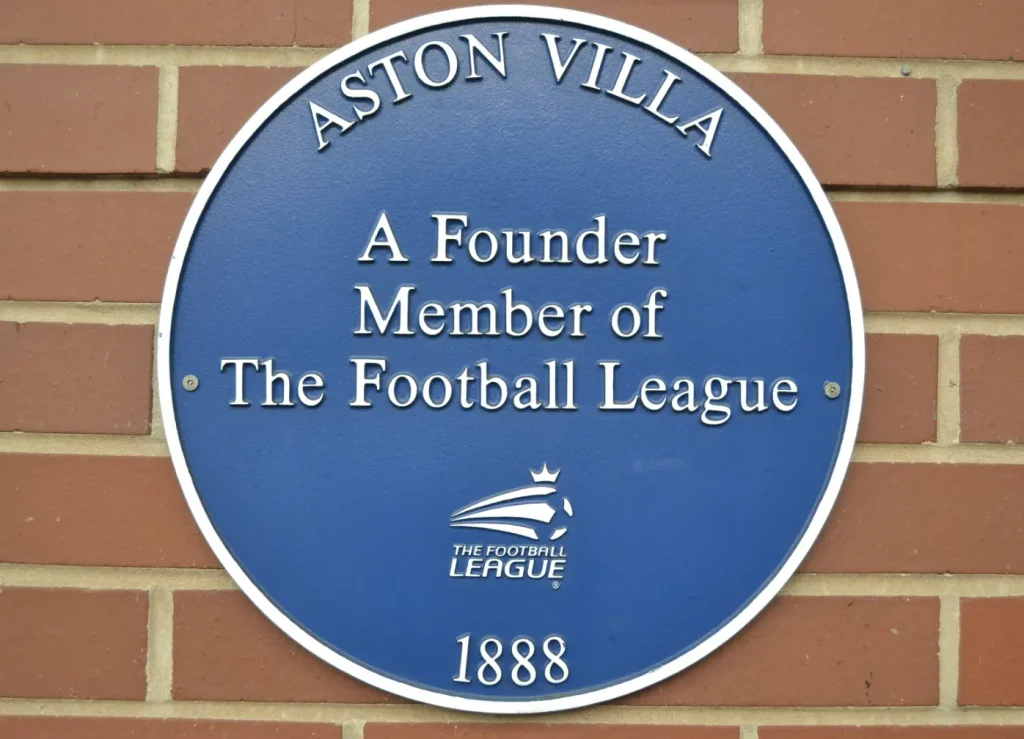
Notable Early Players and Salaries
In the early days of professional soccer, players earned modest sums compared to today’s standards. Salaries varied widely but were generally enough to provide a working-class living. Notable early players included Steve Bloomer of Derby County, one of the first soccer stars known for his incredible goal-scoring ability. Another was Billy Meredith of Manchester City and Manchester United, famous for his skill on the pitch and advocating for players’ rights, including better wages and the abolition of the maximum wage rule.
- The maximum wage for players was introduced in 1901, set at £4 per week, which remained in place until 1961.
- The first professional soccer match under the Football League was played in 1888, with Preston North End emerging as the inaugural champions, ending the entire season unbeaten.
- Early professional games attracted thousands of spectators, highlighting the sport’s growing popularity and the community’s willingness to pay to watch soccer, thereby further fueling its professionalization.
The evolution of soccer into a professional sport was a critical development in its history, allowing it to become the global phenomenon it is today. These early years laid the foundations for professional leagues worldwide, showcasing the sport’s ability to captivate and inspire, both on and off the field.
History of Soccer Timeline
- 2600 BC: The earliest accounts of cuju, a game resembling soccer, are recorded in China, highlighting the ancient origins of ball sports.
- 500-400 BC: In Greece and Rome, games involving a ball and team play are widespread, contributing to soccer’s lineage.
- 12th Century: Across England, mass football matches become common, often leading to disorder but playing a crucial role in soccer’s evolution.
- 1863: The English Football Association is formed, standardizing the rules of soccer and distinguishing it from rugby.
- 1872: The first official international soccer match is played between England and Scotland.
- 1904: The Fédération Internationale de Football Association (FIFA) is established, signaling the start of international soccer governance.
- 1930: Uruguay hosted and won the inaugural FIFA World Cup, the beginning of the world’s premier soccer tournament.
- 1950: The Miracle of Bern, where West Germany defeated Hungary in the World Cup final, highlights soccer’s unpredictability and drama capacity.
- 1971: The establishment of the first women’s soccer team, leading to the growth of women’s competitions worldwide.
- 1985: The Heysel Stadium disaster underscores the need for improved safety and fan behavior regulations in soccer.
- 1991: The first FIFA Women’s World Cup is held in China, marking a significant step forward for women’s international soccer.
- 1994: The United States hosts the FIFA World Cup, significantly boosting soccer’s popularity in the country.
- 1996: Major League Soccer (MLS) was founded in the United States, establishing a professional soccer league to continue the sport’s growth domestically.
- 2018: The FIFA World Cup in Russia sets new viewership records, demonstrating soccer’s global appeal.
- 2026: The FIFA World Cup will be hosted once again in the US in conjunction with Mexico and Canada and is promising to be the biggest one yet.
The Evolution of Soccer in the United States
Soccer’s evolution in the United States from its early foundations is a story of gradual growth, cultural integration, and the development of a unique soccer identity within the global context. Unlike in many countries where soccer quickly became the dominant sport, the journey of soccer in the U.S. has been characterized by periods of modest growth punctuated by moments of significant advancement.
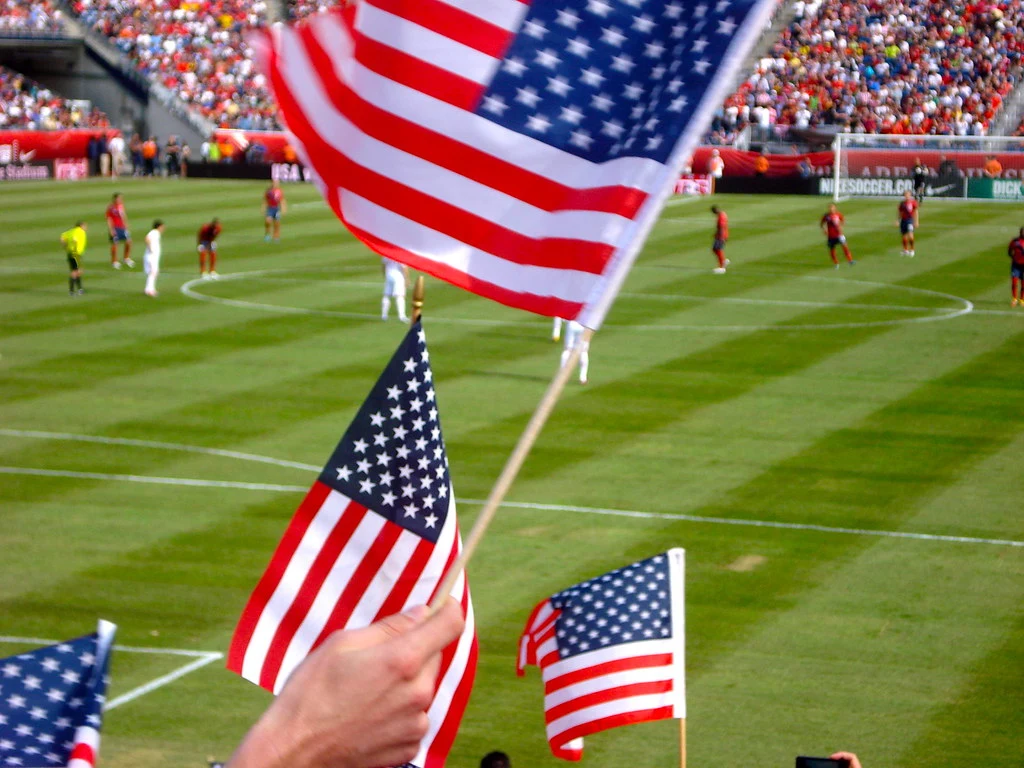
Early 20th Century: Initial Growth
The first soccer seeds in the United States were planted in the late 19th and early 20th centuries, with immigrants from Europe and elsewhere bringing their love for the game to American shores. Clubs and amateur leagues began to form in communities with high immigrant populations, particularly in the Northeast and Midwest.
However, soccer’s presence was overshadowed by American football, baseball, basketball, and other sports that were growing in popularity and institutional support.
1920s-1950s: The American Soccer League
The American Soccer League (ASL), established in 1921, was among the first attempts to organize soccer professionally in the U.S. The league enjoyed success in the 1920s, attracting decent crowds and featuring talented domestic and international players. However, internal conflicts, the Great Depression, and the onset of World War II led to a decline in the league’s prominence and stability.
1960s-1970s: NASL and the Pele Effect
The next significant leap for soccer in the U.S. came with the formation of the North American Soccer League (NASL) in 1968. The NASL’s ambitious strategy included bringing international stars to play in the U.S., with the most notable being Brazilian legend Pelé, who joined the New York Cosmos in 1975. The arrival of Pelé and other stars like Franz Beckenbauer and George Best sparked a soccer boom, with attendance at NASL games reaching record highs.
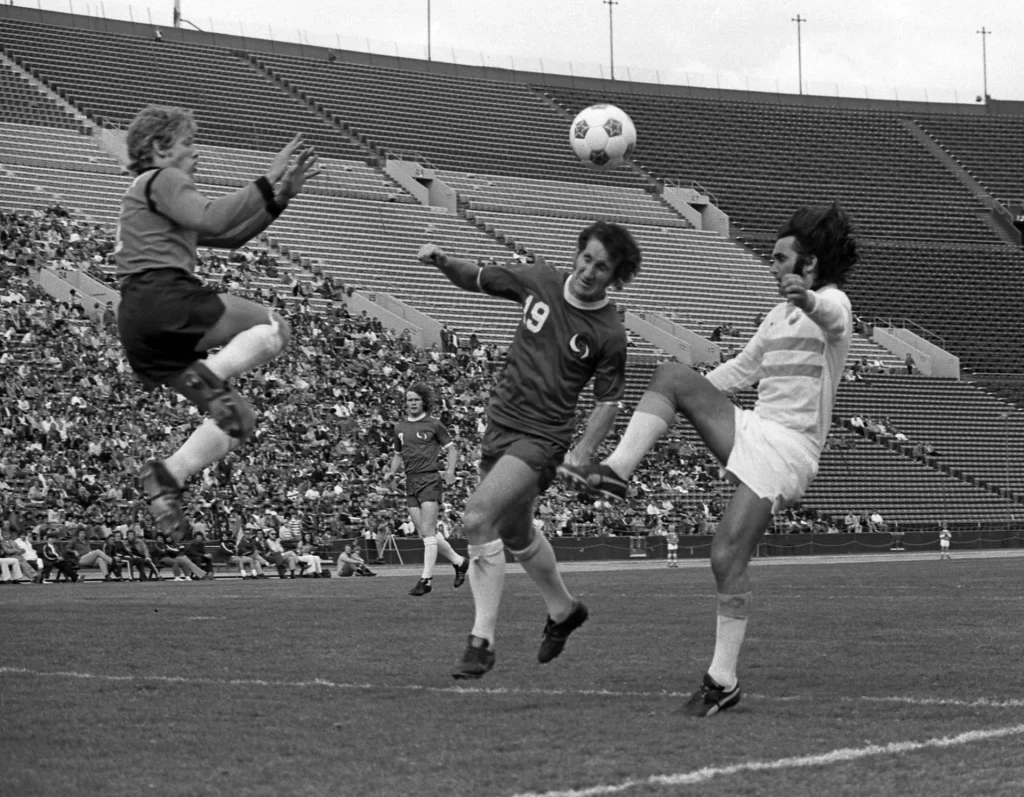
Image Source: George Best vs NY Cosmos
This period also saw the first significant attempt to establish soccer as a mainstream professional sport in the U.S.
1980s-1990s: Decline and Rebirth
Following the dissolution of the NASL in 1984, soccer in the U.S. entered a period of uncertainty. However, the sport continued to grow at the youth and collegiate levels, laying the groundwork for its resurgence. The turning point came with the successful bid to host the 1994 FIFA World Cup. The tournament’s unprecedented success in terms of attendance and domestic interest was a catalyst for soccer’s rebirth in the U.S.
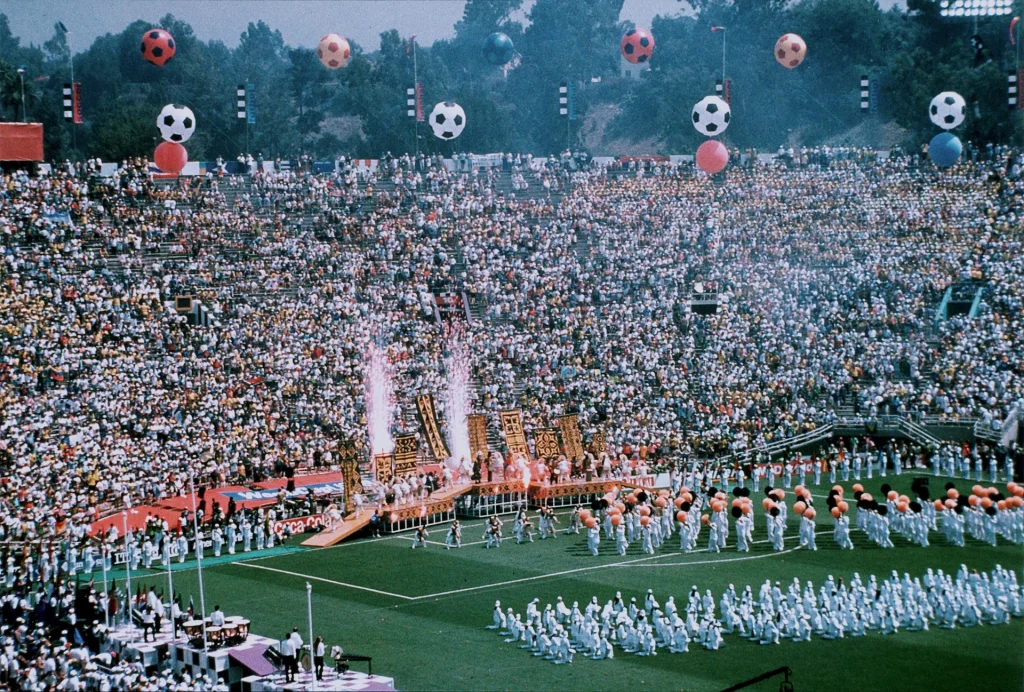
Post-1994: Major League Soccer and Beyond
In the wake of the 1994 World Cup, Major League Soccer (MLS) was launched in 1996 as part of the bid’s promise to establish a sustainable professional soccer league. Despite initial struggles, MLS has grown into a stable and expanding league, with an increasing number of teams, improved infrastructure, and rising attendance.
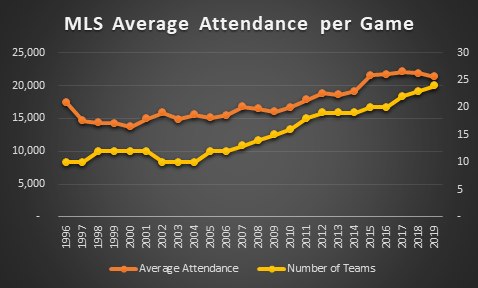
The introduction of Designated Player rules allowed teams to sign international stars, further boosting the league’s profile.
Simultaneously, the U.S. women’s national team emerged as a powerhouse in international soccer, winning multiple FIFA Women’s World Cup titles and Olympic gold medals, which significantly popularized the sport among women and girls.

The evolution of soccer in the United States, from its modest beginnings to its current status as a major sport, reflects a journey of persistence, cultural integration, and strategic development.
With a growing fan base, successful professional leagues, and a vibrant youth soccer system, soccer’s place in the American sports landscape is firmly established, promising an exciting future for the beautiful game in the U.S.

